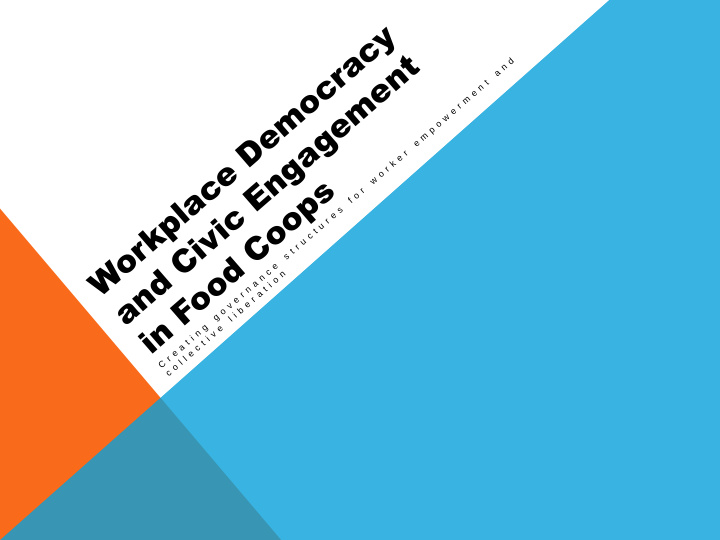



Workplace Democracy and Civic Engagement C r e a t i n g g o v e r n a n c e s t r u c t u r e s f o r w o r k e r e m p o w e r m e n t a n d in Food Coops c o l l e c t i v e l i b e r a t i o n
Agenda 1. Human Timeline 2. Introductions 3. A Vermont Study 4. Collaboration b/w Unions and Worker Coops 5. Questions and Discussion
HUMAN TIMELINE 1.Brainstorm 2.Find your date on the timeline 3.Present 4.Reflect and Discuss
Reflect What stands out to you? Which of these events did you know about? Which ones did you not know about? Are there key events that are missing?
INTRODUCTIONS
A Study on Vermont Food Coops Objective The objective of this project is to examine how individuals and institutions (both inside and outside the workplace) construct citizenship and factors of citizenship that both constrain and encourage political engagement and workplace democracy in the food coops. For the purpose of this project, citizenship will be defined in terms of social, political, and civil rights.
Case Study Sites City Market Cooperative Hunger Mountain Cooperative
Theoretical Framework Mapping Citizenship T .H. Marhsall breaks down citizenship into social, political, and civil rights Workplace Democracy A model for the engagement of the political rights and duties connected to citizenship in the workplace (Fantasia et al., 1988)
Methods Focus Groups Interviews Policy Analysis Document Analysis
Research Approach Community Based Action Research Collaborative Participatory Transparent Accountable Explanatory Case Study Uncovering the cause and effect relationship of citizenship constraints
Preliminary Findings Many workers are either on the verge of or completely unable to support themselves and their dependents on their present earnings Dependence on government assistance programs is common Workers maintain varying levels of understanding and involvement in the decision- making processes offered by the union and management The main benefit of having a union is job security The main downfall of having a union is select individuals not pulling their weight Some workers questioned whether or not the union was necessary based on their feelings about the cooperative Some workers looked on the cooperative store with disdain for it’s corporatization
Modern Examples of Projects for Partnership United Steel Workers Union In 2009, the United Steelworkers Union announced a collaboration with Mondragon to form “union-coops” In union-coops, employees can join the union of their choice and be guaranteed living wage, benefits, and collective bargaining agreement In some new union-coops, workers get ownership shares in enterprise which they pay for over time out of their paychecks Workers vote on management team who they then collectively bargain with to establish wages, benefits, and procedure for handling conflict
Projects for Partnership (cont.) United Electrical, Radio and Machine Workers of America In August of 2013, UE officially launched a campaign to partner with worker cooperatives after spending approximately one year laying groundwork Potential benefits for union affiliated worker cooperatives include assistance with benefits administration, negotiating healthcare plans, retirement plans, apprenticeship between worker cooperatives, third party grievance procedure Growing partnership in New York City
Discussion questions What is the potentiality of these three systems coalescing? Who is best represented in each system? Can the cooperative principles be applied to a system universally?
Recommend
More recommend